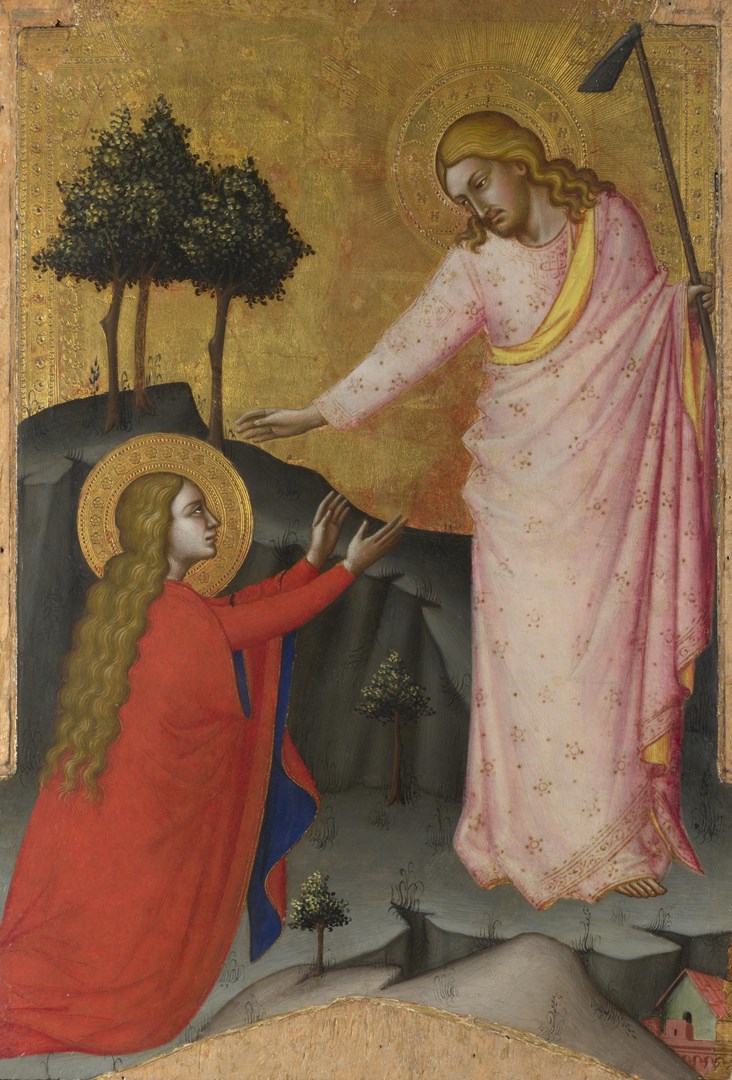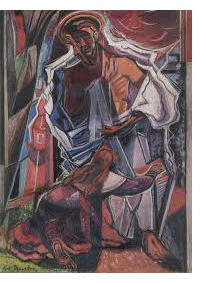
Holy Week: Easter
A reflection by The Revd Dr Jarred Mercer, Associate Chaplain and Career Development Researcher at Merton College.
- Download 'Easter Sunday 2020 - a reflection' (PDF format)

Reading: John 20:1–18
‘Mary stood weeping outside the tomb’ (John 20:11)
Jesus said to her, ‘Mary’ (John 20:16)
‘Mary Magdalen went and announced to the disciples, ‘I have seen the Lord’ (John 20:18)
Easter is synonymous with joy, with celebration, renewal, and life—and rightly so. The word ‘Alleluia’ can now be proclaimed in the liturgy again after the ‘A’ word has been suppressed during the season of Lent. Some churches even have children hide ‘alleluias’ in the church only to reveal them again at Easter (typically pieces of card or paper with the word ‘alleluia’ written on them). It is so natural to see this time as pure rejoicing—as only and always a cry of ‘Alleluia!’. And rejoice we should, we must. But this year at Easter the rejoicing might have an opportunity to grow still more, the cry of ‘Alleluia!’ louder than before as our hunger to gather, to rejoice together, to be freed from the current anxieties and fears and uncertainties of our world has intensified. Much of what we take for granted every day has slipped through our grasp and maybe because of this we can identify just that much closer in a way to Christ’s followers on Easter morning.
At the first Easter, Jesus’ followers do not gather to rejoice. The disciples are hiding out in fear and mourning the loss of Christ. Peter and John seem to be running back and forth to the tomb in complete bafflement when they hear that Jesus is not there. And, of course, there is the shock, grief, and horror of Mary Magdalen (and the other women mentioned in the Gospel of Mark as Mary the mother of James and Salome), who comes to the tomb with oil and spices in hand to finish the anointing began on Holy Monday in Bethany, only to see that it is empty, that Christ, to her mind, has been taken. And Mary Magdalen could do nothing but stand outside the tomb, weeping. Taken already from her in his death and now ripped away still further, still more out of reach, more and more—gone. There is no room for ‘Alleluia’ here, just yet. On the first Easter morning, Christ’s friends were not ready. They could not wrap their minds around the idea of resurrection.
But thankfully they do not get an ‘idea’ of resurrection, but a tangible, real, body—Jesus of Nazareth—standing before them, embracing them, dining with them.  The crucified and risen Jesus is not to be understood, he is to be seen, to be known, to be touched. One has only to think of ‘doubting Thomas’ reaching out to put his hands to Jesus’ wounds—believing through touch—to begin to grapple with the visceral beauty of the resurrection (John 20:17–28).
The crucified and risen Jesus is not to be understood, he is to be seen, to be known, to be touched. One has only to think of ‘doubting Thomas’ reaching out to put his hands to Jesus’ wounds—believing through touch—to begin to grapple with the visceral beauty of the resurrection (John 20:17–28).
Even the famous noli me, tangere, the request ‘do not hold on to me’, that Christ gives Mary Magdalen outside the tomb, is given from the mouth of this renewed body; from the arms that support her as she crashes into him, from the voice and breath that sends her to the other disciples to become the first witness to proclaim the resurrection; from the creative blessing of his word as he speaks her name, ‘Mary’, and changes her life forever. Our Gospel, our joy, our Easter extends straight back to the tender service, the faithful listening, the loving touch of this Mary of Magdala. And it comes from the midst of her grief and confusion—looking up through mucky eyes flooded with tears to vaguely see the outline of a man in a garden whom she mistakes to be the gardener. It comes from her still unsettled grief and the sorrow she has felt these past two days and nights (those who have met grief in their lives know that it does not go away—there is no getting ‘over it’), to an elated new cry reaching her trembling, weeping lips: ‘I have seen the Lord’.
The details of the biblical accounts of Christ’s resurrection show at every turn vividly the paradoxical joy of Easter: rejoicing, yes, but rejoicing out of sorrow; new life, yes, but life that comes from death. Even the location of the risen Christ meeting Mary Magdalen illustrates this beautifully. Jesus’ isolation, loneliness, struggle, and pain in a garden of Gethsemane is contrasted here with reunion, joy, and embrace at the garden of the tomb. But ‘contrasted’ doesn’t really cut it. They are not contrasting one another so much as fulfilling one another. ‘Alleluia’, ‘Alleluia’, ‘Alleluia’, we cry—but from our depths. Alleluias well up from mucky teared eyes, from grief and burden, from crosses and tombs. And not because we glamorize suffering or fetishize our pain, far from it. Alleluias come from the depths of us because that is where we meet Christ among us. To say with Mary, ‘I have seen the Lord’, is the heart of all our joy, but that Lord is the Lord who died on Good Friday, who was in the grave on Saturday, and who stands before us forever with the marks of the nails, the thorns, the spear—who stands before us and welcomes us forever as the crucified one.
![]() There is nothing more joyful, nothing worth more ‘Alleluias’ than this. Because we know, as we meet Christ—Emmanuel, God’s perfect love alive among us—in the garden of the tomb, in the tears of the grieving, in the fear of the frightened, that we meet the risen Christ everywhere. That whatever we find there, at the depths of us, none of it is too far for that perfect, ever-new love of God to reach. Christ is not the once crucified and then later resurrected one. He is forever and always Christ, crucified and risen, who leaves no part of us behind but bears all the wounds of the cross and carries all our brokenness through to new, resurrection life.
There is nothing more joyful, nothing worth more ‘Alleluias’ than this. Because we know, as we meet Christ—Emmanuel, God’s perfect love alive among us—in the garden of the tomb, in the tears of the grieving, in the fear of the frightened, that we meet the risen Christ everywhere. That whatever we find there, at the depths of us, none of it is too far for that perfect, ever-new love of God to reach. Christ is not the once crucified and then later resurrected one. He is forever and always Christ, crucified and risen, who leaves no part of us behind but bears all the wounds of the cross and carries all our brokenness through to new, resurrection life.
Wherever you find yourself, however deep you might be in the depths of your life or your circumstances: Look up, listen for Christ speaking your name into that new life and hope; speaking your name into the glory of resurrection.
Christ is risen. He is risen indeed. Alleluia.
Collect for Easter
Lord of all life and power,
who through the mighty resurrection of your Son
overcame the old order of sin and death
to make all things new in him:
grant that we, being dead to sin
and alive to you in Jesus Christ,
may reign with him in glory;
to whom with you and the Holy Spirit
be praise and honour, glory and might,
now and in all eternity. Amen.